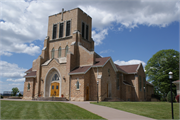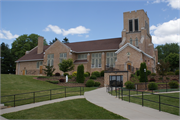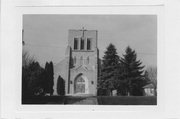Property Record
N6235 COUNTY HIGHWAY V
Architecture and History Inventory
| Historic Name: | |
|---|---|
| Other Name: | HOLY ROSARY CATHOLIC CHURCH |
| Contributing: | |
| Reference Number: | 24755 |
| Location (Address): | N6235 COUNTY HIGHWAY V |
|---|---|
| County: | Pepin |
| City: | |
| Township/Village: | Lima |
| Unincorporated Community: | |
| Town: | 25 |
| Range: | 12 |
| Direction: | W |
| Section: | 19 |
| Quarter Section: | NE |
| Quarter/Quarter Section: | SE |
| Year Built: | 1936 |
|---|---|
| Additions: | C. 1996 |
| Survey Date: | 19822012 |
| Historic Use: | church |
| Architectural Style: | Late Gothic Revival |
| Structural System: | |
| Wall Material: | Brick |
| Architect: | John Flad of Flad and Moultin |
| Other Buildings On Site: | Y |
| Demolished?: | No |
| Demolished Date: |
| National/State Register Listing Name: | Not listed |
|---|---|
| National Register Listing Date: | |
| State Register Listing Date: |
| Additional Information: | POINTED ARCHED WINDOWS AND ENTRYSQUARE TOWER CENTERED ON FRONT Holy Rosary Catholic Church has historically been the religious, educational and social center of the Austrian Catholics of the Town of Lima since the late nineteenth century. The construction of its first edifice in 1886 was the direct result of the growing numbers of Austrian Catholic immigrating to the area in the 1870s, many of which came from the Village of Purbach-Schrembs and the diocese of St. Poeltin in lower Austria. Catholics residing in the Town of Lima initially traveled to nearby Durand for services; however, after petitioning the La Crosse Diocese, they were granted permission to build their own church. The parish purchased ten acres on which the church now stands from Anton Faast; the location on CTH V was favorable because it was considered equidistant for all parishioners in the township. Joseph Spindler donated ground for the cemetery. The first 1886 edifice, a 50 x 70 foot frame church, was designed by the firm of Francis Ihli and Thomas Gruber of Eau Claire. By the 1930s, the church had become too small for the approximately 190 families belonging to the parish and it was replaced by the present Neo-Gothic Revival style church in 1936. It was designed by John Flad of Flad and Moulton architects, and the E. Hackner Company of La Crosse furnished the altars, sanctuary wainscoting, communion railings, confessionals, and pews. Oberammergau wood-carvers employed by the Hackner Company executed the crucifix of the High Altar and the statures of the side altars. The $70,000 church was dedicated on May 17, 1937. The continued growth of the church led to the construction of other religious buildings on the property, including a rectory in 1912 (replaced with the present in 1951), and a school in 1915 (replaced with the present in 1981). A cemetery associated with the parish is located directly south of the church, and dates from the late nineteenth century. |
|---|---|
| Bibliographic References: | Curtiss-Wedge, Franklyn, History of Buffalo and Pepin Counties (Winona, MN: H.C Cooper, Jr., & Co., 1919);, Pepin County History Book Committee, Pepin County History (Dallas, Texas: Taylor Publishing Company, 1985); Holy Rosary Parish Church History Committee, Holy Rosary Parish Lima, Wisconsin, 1886-1986 (Durand, WI: Holy Rosary Parish, 1986) “Architecture/History Survey: Reconstruct CTH V: USH 10 To Forster Rd. WHS project number 12-0941/PE. June 2012. Prepared by Rachel E. Bankowitz. |
| Wisconsin Architecture and History Inventory, State Historic Preservation Office, Wisconsin Historical Society, Madison, Wisconsin |



